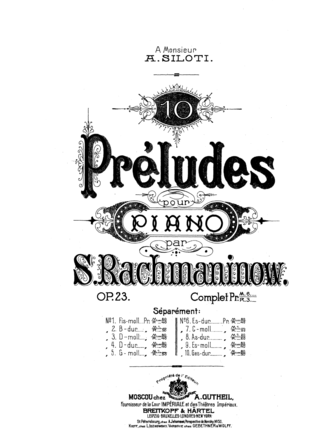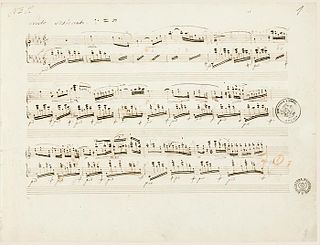
The Rhapsody on a Theme of Paganini, Op. 43, is a concertante work written by Sergei Rachmaninoff for piano and orchestra, closely resembling a piano concerto, all in a single movement. Rachmaninoff wrote the work at his summer home, the Villa Senar in Switzerland, according to the score, from 3 July to 18 August 1934. Rachmaninoff himself, a noted performer of his own works, played the piano part at the piece's premiere on 7 November 1934, at the Lyric Opera House in Baltimore, Maryland, with the Philadelphia Orchestra conducted by Leopold Stokowski.

Six moments musicaux, Op. 16, is a set of solo piano pieces composed by the Russian composer Sergei Rachmaninoff between October and December 1896. Each Moment musical reproduces a musical form characteristic of a previous musical era. The forms that appear in Rachmaninoff's incarnation are the nocturne, song without words, barcarolle, virtuoso étude, and theme and variations.
Sergei Rachmaninoff's Prelude in C-sharp minor, Op. 3, No. 2, is one of the composer's most famous compositions. Part of a set of five piano pieces titled Morceaux de fantaisie, it is a 62-bar prelude in ternary (ABA) form. It is also known as The Bells of Moscow since the introduction seems to reproduce the Kremlin's most solemn carillon chimes.

The Nocturnes, Op. 9 are a set of three nocturnes for solo piano written by Frédéric Chopin between 1831 and 1832, published in 1832, and dedicated to Madame Marie Pleyel. These were Chopin's first published set of nocturnes. The second nocturne of the work is often regarded as Chopin's most famous piece.

Johannes Brahms's Violin Sonata No. 3 in D minor, Op. 108 is the last of his violin sonatas, composed between 1886 and 1888. Unlike the two previous violin sonatas, it is in four movements. The sonata is dedicated to Brahms' friend and colleague Hans von Bülow, and was premiered in Budapest in 1888 with Jenő Hubay on violin and the composer at the piano.
The Piano Sonata in A minor D. 845 (Op.42) by Franz Schubert is a sonata for solo piano. Composed in May 1825 and entitled Premiere Grande Sonata, it is the first of three sonatas published during the composer's lifetime, the others being D.850 and D.894. Conceived as a set, these works were composed during what was reportedly a period of relatively good health and spirits for Schubert, and are praised for their quality and ambition. This first sonata in particular marks a significant step toward the composer’s mature piano sonata style; the format and several characteristic stylistic elements continue through the last.

Ten Preludes, Op. 23, is a set of ten preludes for solo piano, composed by Sergei Rachmaninoff in 1901 and 1903. This set includes the famous Prelude in G minor.

The Nocturnes, Op. 27 are a set of two nocturnes for solo piano composed by Frédéric Chopin. The pieces were composed in 1836 and published in 1837. Both nocturnes in this opus are dedicated to Countess d'Appony.
Ballade in the Form of Variations on a Norwegian Folk Song in G minor, Op. 24, is a large-scale work for piano by Edvard Grieg. It is in the form of theme and variations, the theme being the Norwegian folk song Den nordlanske bondestand. A performance usually lasts around 20 minutes.

The Piano Quartet No. 1 in G minor, Op. 25, was composed by Johannes Brahms between 1856 and 1861. It was premiered in 1861 in Hamburg, with Clara Schumann at the piano. It was also played in Vienna on 16 November 1862, with Brahms himself at the piano supported by members of the Hellmesberger Quartet. Like most piano quartets, it is scored for piano, violin, viola, and cello.

The Nocturnes, Op. 55 are a set of two nocturnes for solo piano written by Frédéric Chopin. They are his fifteenth and sixteenth installations in the genre, and were composed between 1842 and 1844, and published in August 1844. Chopin dedicated them to his pupil and admirer Mademoiselle Jane Stirling.

Sergei Rachmaninoff's Polka de W.R. is a virtuoso piano arrangement of Franz Behr's Lachtäubchen (Scherzpolka) in F major.

The Prelude in B-Flat Major, Op. 23 No. 2 is a composition by Sergei Rachmaninoff completed and premiered in 1903.

The Prelude in D Minor, Op. 23 No. 3 is a composition by Sergei Rachmaninoff completed and premiered in 1903.

The Prelude in C minor, Op. 23, No. 7 is a 1903 composition by Sergei Rachmaninoff. It is part of Rachmaninoff's Ten Preludes, Op. 23.

The Prelude in A-flat major, Op. 23, No. 8, is a 1903 composition by Sergei Rachmaninoff. It is part of Rachmaninoff's Ten Preludes, Op. 23.

The Prelude in G-Flat Major, Op. 23 No. 10 is a 1903 composition by Sergei Rachmaninoff. It is part of Rachmaninoff's Ten Preludes, Op. 23.
Alexander Scriabin's 24 Preludes, Op. 11 is a set of preludes composed in the course of eight years between 1888–96, being also one of Scriabin's first published works with M.P. Belaieff in 1897, in Leipzig, Germany, together with his 12 Études, Op. 8 (1894–95).
The Terzetto in C major, Op. 74 (B. 148), is a chamber work for two violins and viola by the Czech composer Antonín Dvořák, published in 1887.

Bridal Suite is a suite for two pianists by American composer Leonard Bernstein. Composed in 1960, it was written for Phyllis Newman's wedding with Adolph Green.





















